SIEMENS Q250H 50A Type QPH Circuit Breaker for Level 2 EV Chargers
The Siemens Q250H is a 50A, 2-pole, plug-in circuit breaker with a 22kA interrupt rating – ideal for high-fault current levels or complex 240V Level 2 EV charger circuits in Siemens PL and ES load centers.
The SIEMENS Q250H is a 50 Amp, 2-pole, plug-in Type QPH circuit breaker I recommend for 240V 40A Level 2 EV charger installations – especially in modern homes where high interrupt ratings are essential for safe, code-compliant EV charger branch circuits. With a 22,000 AIC interrupt rating, the Q250H offers superior short-circuit protection compared to the standard Siemens Q250, which is rated at only 10,000 AIC. This makes the breaker ideal for EV charger installations in homes near utility transformers or for commercial Level 2 EV charging setups.
As an EV charger installer, I often see homes equipped with Siemens PL or ES series load centers, especially in new construction or major electrical upgrades. These homes are typically paired with higher-capacity service panels, where the available fault current at the main panel can exceed 10kA. In these scenarios, a standard 10kA Type QPH circuit breaker breaker may not offer sufficient protection. The Q250H, with its robust 22kA interrupt rating, ensures overload and short-circuit protection for high-load EV charging circuits – such as those using high-amperage adjusted EV chargers wired to a 50A circuit – without compromising on the installation and EV charging safety.
Unlike older breakers or standard residential models, the Q250H is designed for plug-in mounting and slides smoothly into Siemens PL and ES series load centers. Its factory-new construction and UL listing ensure compliance with NEC requirements, making it an ideal breaker for both retrofit EV charger installations and new 240V EV charging circuit builds.
We tested the Siemens Q250H in a dedicated 50A EV charging circuit featuring a hardwired Wallbox Pulsar Plus 40-Amp EV Charger.
The test EV charger branch circuit included 6 AWG solid copper THHN conductors in ¾-inch conduit, bonded to the Siemens ES load center’s ground and neutral bars per NEC guidelines.
Installation into the Siemens ES Series Load Center was seamless – The Q250H breaker locked in securely, with no lateral wiggle or loose connection which is a common issue with aftermarket or lower-rated breakers that can cause EV charging failures – Once installed, the Q250H handled the full 9.60 kW load of the 40A EV charger without nuisance tripping, overheating, or voltage fluctuations. For more than 15 charging sessions – including back-to-back overnight charges in warm California environments the Q250H delivered uninterrupted, cool operation with no signs of thermal stress or contact wear.
Why the 22kA Interrupting Capacity Matters for EV Charging
EV charging circuits are high-current applications. If a short circuit occurs on a 240V 50A EV charging branch circuit, the resulting fault current can rise dramatically – especially in homes with high-capacity service panels. A standard 10kA-rated breaker, such as the Siemens Q250, may not safely handle these fault levels and might even require a service panel upgrade.
The Siemens Q250H, with its 22kA AIC rating, is built to safely interrupt higher fault currents—providing an essential safety margin in high-risk EV charging installations. These include homes located near utility transformers, commercial buildings, multi-unit dwellings, and complex installations such as solar + EV charger setups with large inverters.
Wiring the Siemens Q250H Breaker for a 240V Level 2 EV Charger
The Siemens Q250H is fully compatible with the most common EV charger wiring configurations and supports both plug-in and hardwired Level 2 EV charger installations rated for 40A operation. Although we tested the circuit breaker on a hardwired Wallbox Pulsar Plus 40-Amp EV Charger, other EV charger configurations are possible depending on your EV charger specifications and electrical panel support, Below are the common EV charger branch circuit wiring methods used with the Q250H for plug-in and hardwired 240V 40A EV chargers:
EV Charger Wiring – 240V (4-Wire: L1, L2, Neutral, Ground) – Q250H Breaker
The 4-wire configuration is commonly used with NEMA 14-50 plug-in EV chargers, with the Siemens Q250H protecting the branch circuit in modern Siemens PL or ES load centers. This configuration is also used when converting NEMA 14-50 EV chargers to hardwired installations, or installation of hardwired EV chargers that allow 4-Wire: L1, L2, Neutral, Ground terminal connections and amperage adjustment to 40A.
As shown in the wiring diagram below, the branch circuit uses two hot wires from the double-pole Siemens Q250H breaker, one neutral, and one ground, typically with 6 AWG solid copper conductors. The neutral and ground are connected to the panel’s busbars per NEC and local code requirements.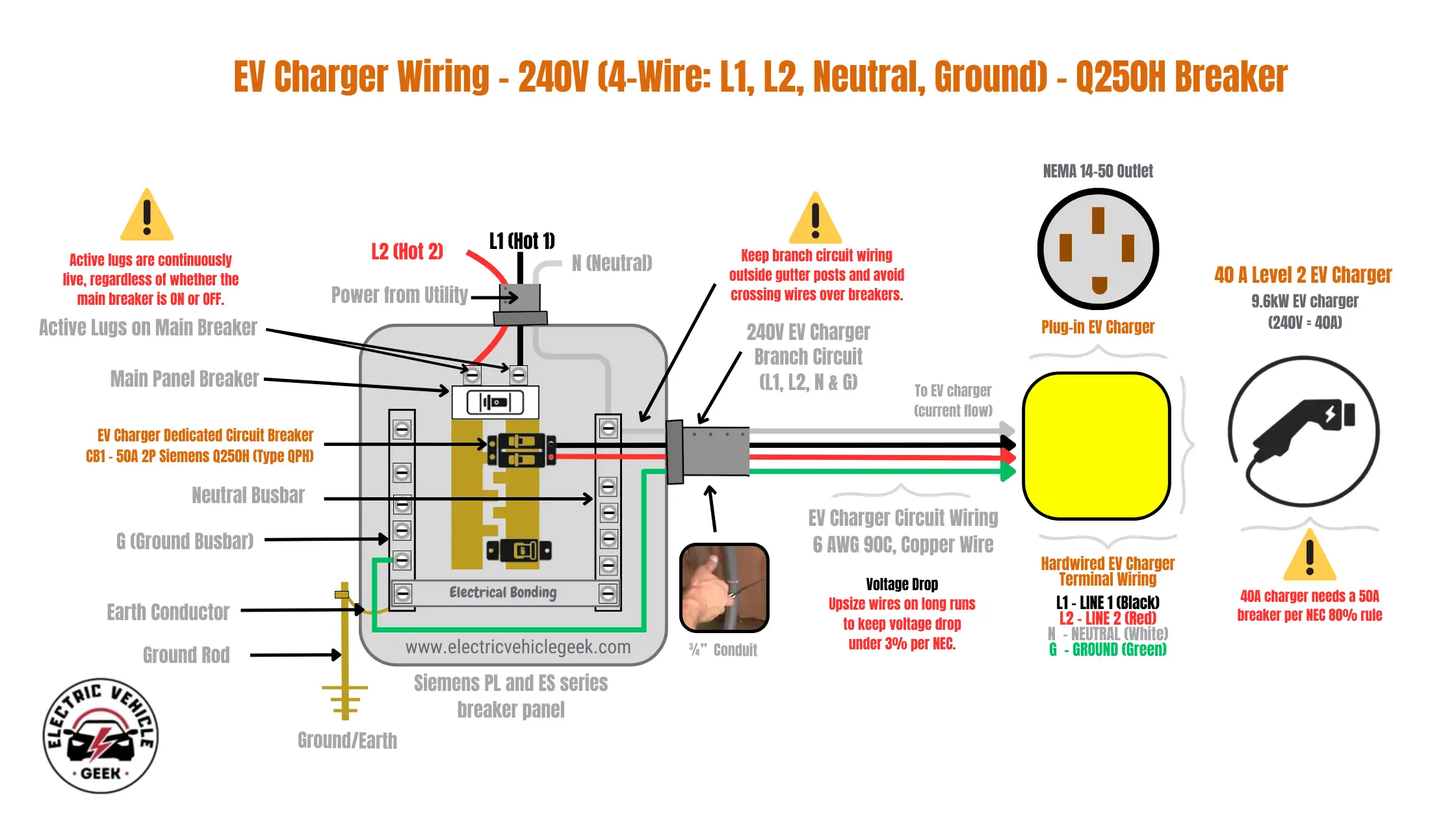
Compatible Level 2 EV Chargers for This Wiring Setup
EV Charger Wiring – 240V (3-Wire: L1, L2, Ground) – Q250H Breaker
Popularly used for hardwired EV charger installations that do not require a neutral – such as the Tesla Wall Connector or hardwired Emporia Pro Level 2 EV charger with their amperage adjusted to 40 A. The 3-wire configuration is also common in NEMA 6-50 EV charger setups using NEMA 6-50 outlets. This 3-Wire: L1, L2, Ground branch circuit uses only two hot wires and ground as shown in the branch circuit wiring diagram below: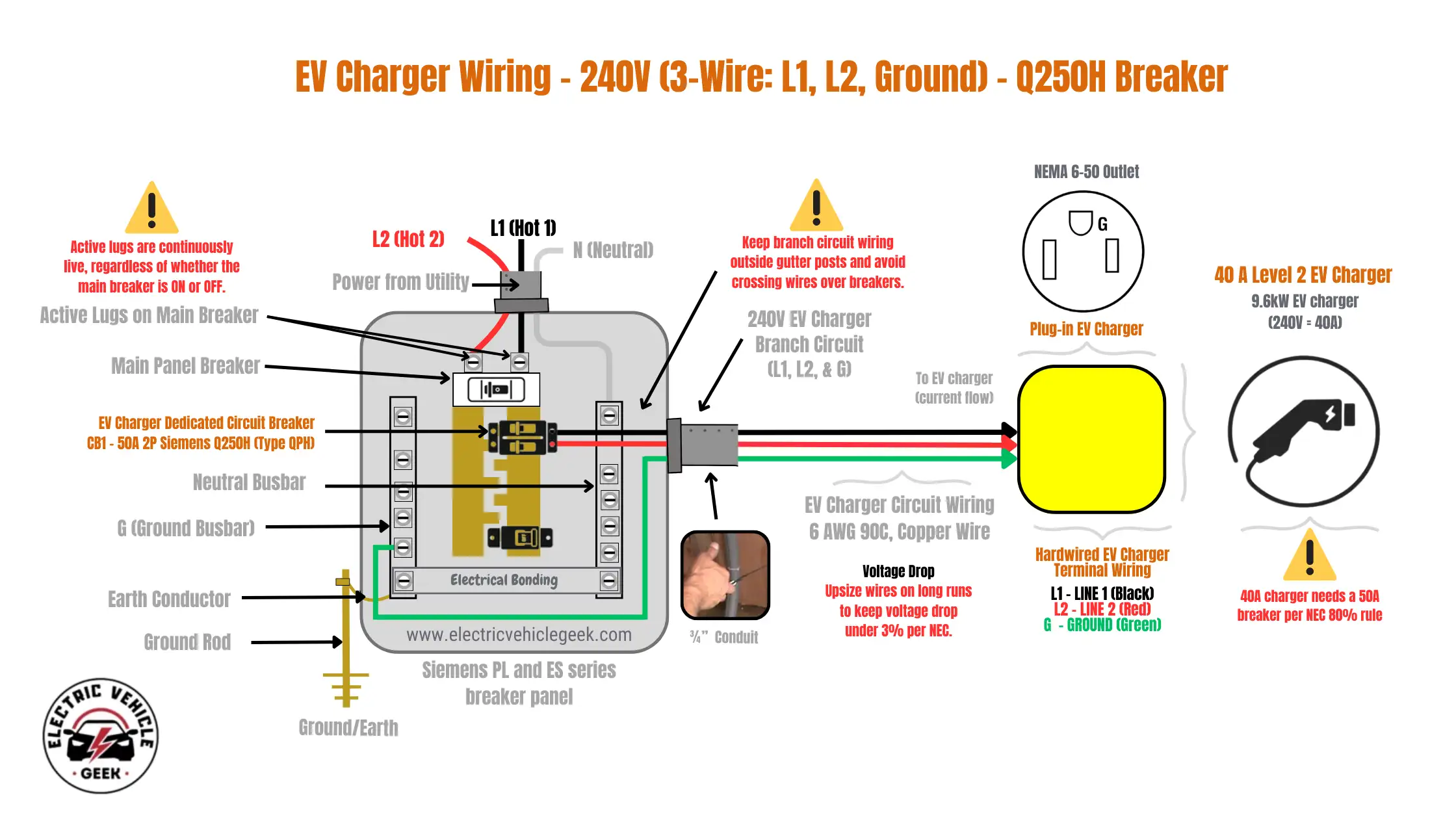
The Siemens Q250H protects this EV charging branch circuit when installed as a dedicated breaker in load centers with separate neutral and ground bars. It’s the preferred method for 240V-only EV chargers, simplifying installation while remaining NEC-compliant.
Compatible Level 2 EV Chargers for This Wiring Setup
EV Charger Wiring – 240V (3-Wire: L1, L2, Neutral) – Q250H Breaker
Although older wiring methods may omit ground, modern EV charger installations must include a dedicated ground for safety. While this configuration may exist in legacy panels in the installation of EV chargers such as NEMA 10-50 EV chargers, it is not considered safe or compliant by current standards. The Siemens Q250H should be used with 3-wire (L1, L2, Ground) or 4-wire (L1, L2, Neutral, Ground) circuits for EV charging.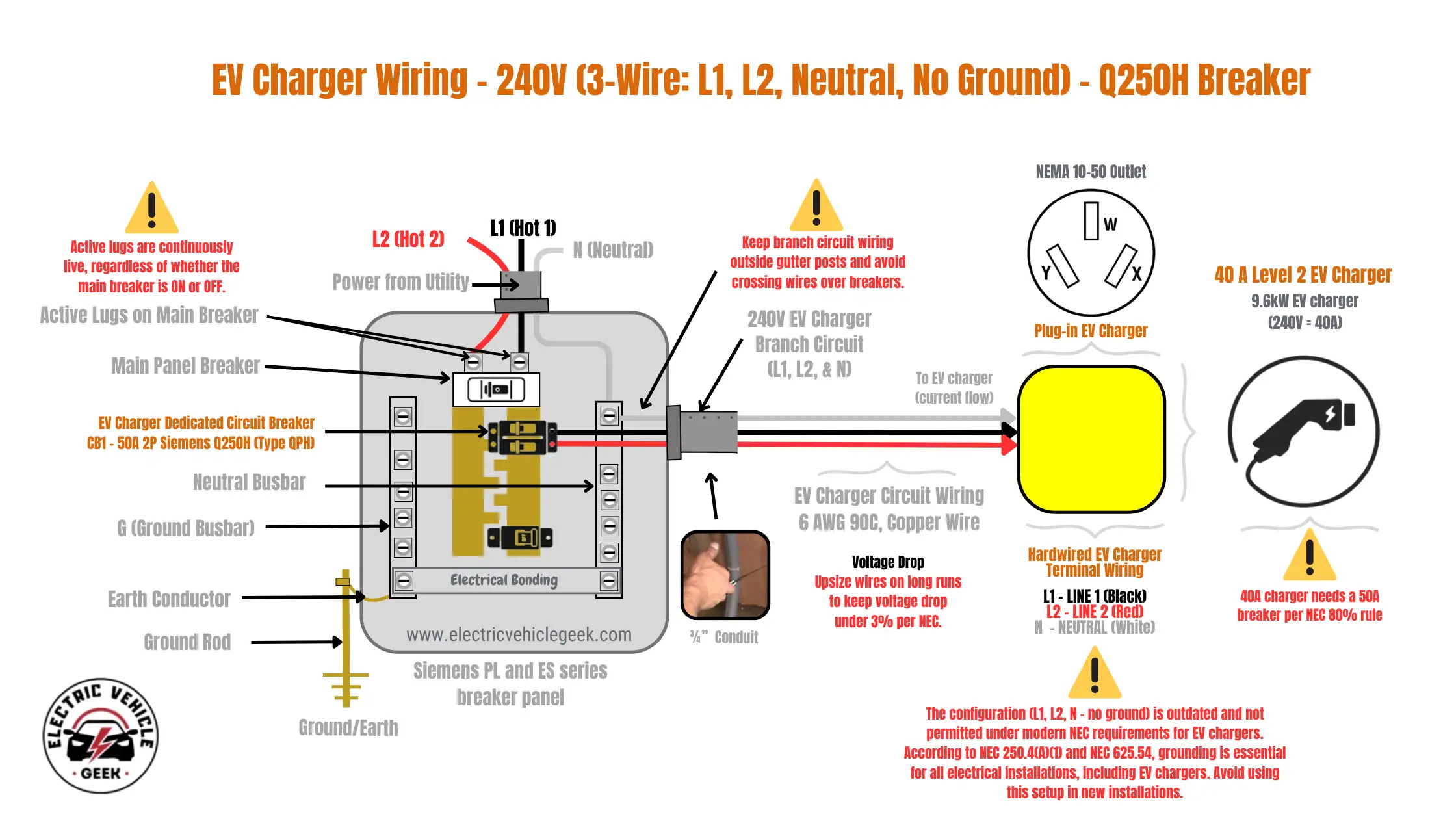
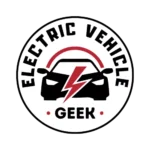
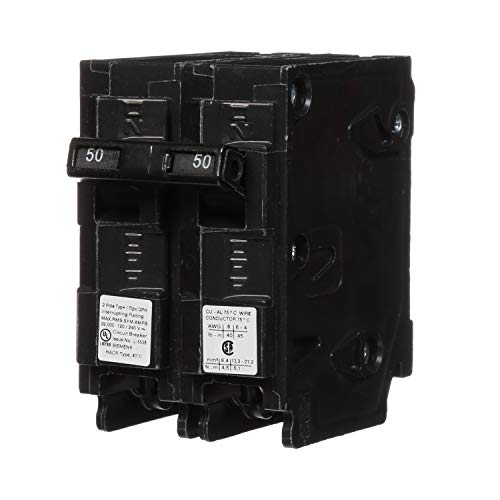
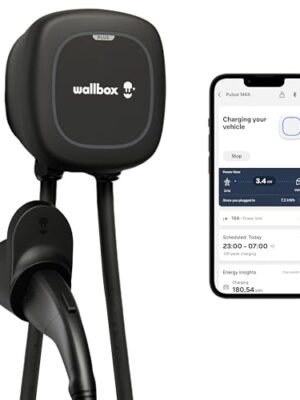
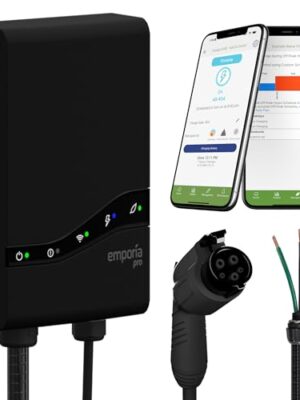
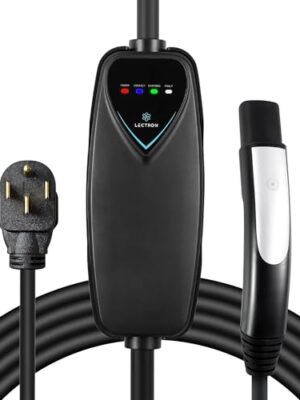
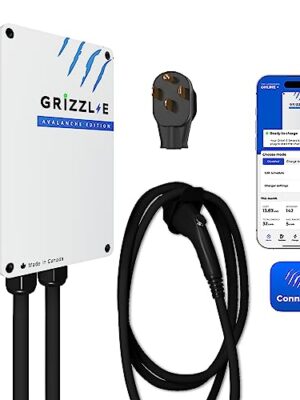
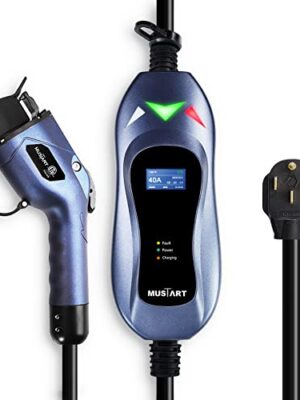
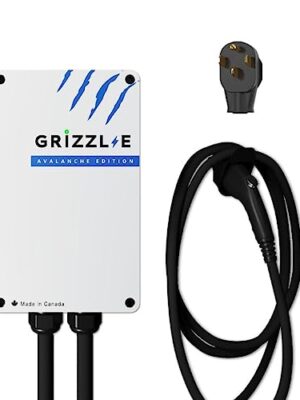
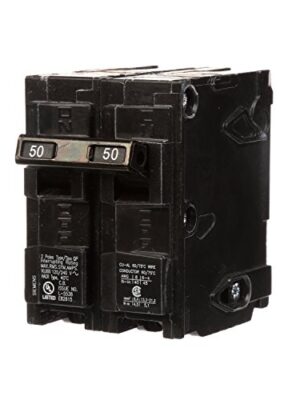
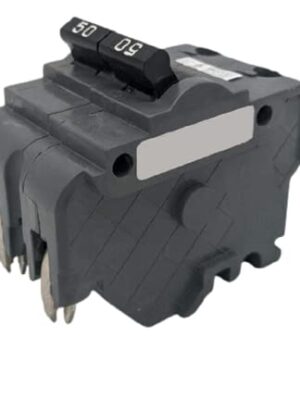
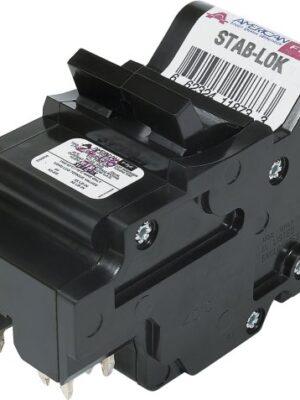
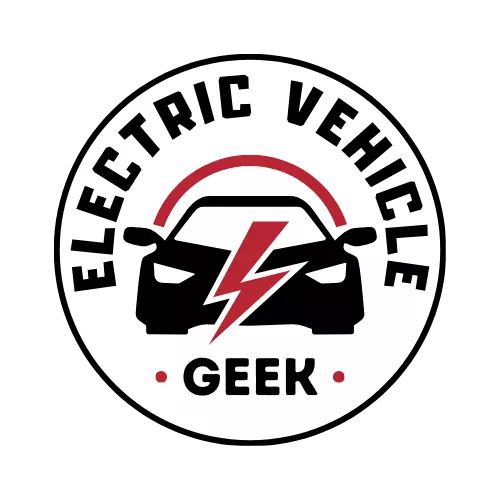
There are no reviews yet.